Status Active Frequency Annually 2017 Date 25 May 2017 Featured in religions Hinduism | Genre Religious Country India Type of holiday Religious celebration | |
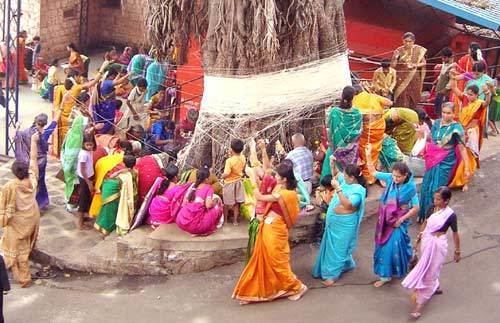 | ||
Observances Puja, Vrata (fast) and feasting | ||
Vat purnima celebration in mumbai
Vat Purnima or Wat Purnima (वट पूर्णिमा, vaṭapūrṇimā, also called Vat Savitri is a celebration observed by married women in the Western Indian states of Gujarat, Maharashtra, and Karnataka. On this Purnima or "full moon" during the three days of the month of Jyeshtha in the Hindu calendar (which falls in May-June in the Gregorian calendar) a married woman marks her love for her husband by tying a ceremonial thread around a banyan tree. The celebration is based on the legend of Savitri and Satyavan as narrated in the epic Mahabharata.
Contents
- Vat purnima celebration in mumbai
- What is vat purnima in goa special on vatpurnima goa
- Legend
- Festival
- Fast and tradition
- References
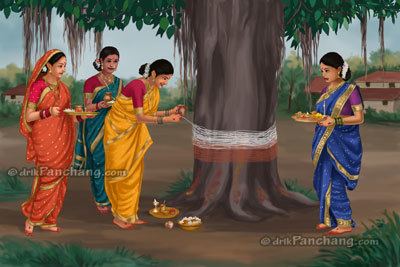
What is vat purnima in goa special on vatpurnima goa
Legend
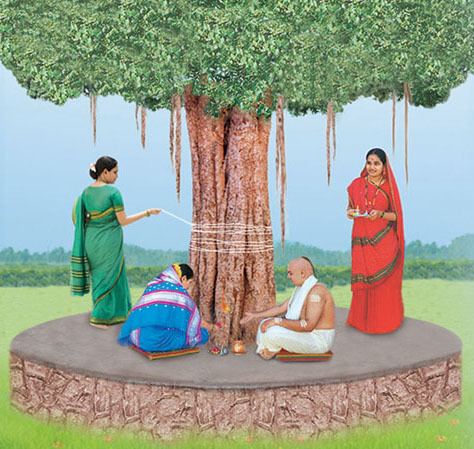
The legends dates back to a story in the age of Mahabharata. It was quoted after a couple Savitri and Satyavan, who are well admired by the Indians for their love towards each other. Satyavan was a son of a king, who was in exile due to his blindness. Soon after the marriage, she has been informed that her husband would die within one year. So Savitri chose to spent the last three days of the year fasting and praying for the welfare of her husband. On the last day of the fast, the couple undertook the task of woodcutting in the nearby forest.
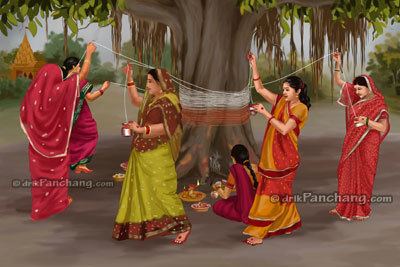
After Satyavan was exhausted of the idea of near death, he rested his death in Savitri's lap, and awaited Yama's (God of death) arrival to part his soul from his body. As predicted, Satyavan died. Savitri placed his body under the shade of a Vat (Banyan) tree, and followed Yama all his way to the abode. It was composed that, Savitri followed Yama, who has been carrying Satyavan's soul, through rough grounds, uneven terrains, across the mountains and forests.
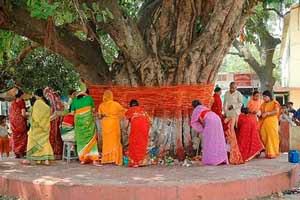
En route, Yama tried to convince Savitri to turn back, but she adamant to leave her husband. She was also offered boons such as restoration of her father-in-law's sight and kingdom, restoration of her parents prosperity, but nothing convinced her. She was relentless and continued to follow him. As they approached Yama's abode, he offered her a final boon. He offered her one hundred sons, but Savitri was tactical enough and reminded Yama that would only be possible if her husband was alive. AT the instant, Yama was forced to accept her logic and Satyavan was back to life under the same Vat tree.
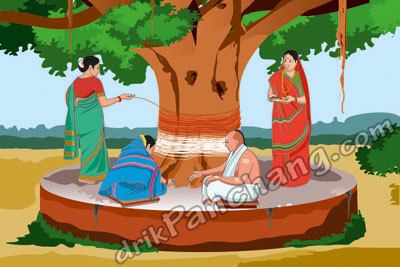
Though the tree doesn't play a significant role of the story, it is worshiped as memory of the love in the legend. The festival is followed my married women only, and is prohibited for children and widows.
Festival
Vat Purnima in English means a full moon related to the Banyan tree. It was a Hindu festival that was strictly celebrated in Deccan area of the southern India. However, in the recent years very few communities follow the tradition. The period of the festival is observed over three days, usually in 13th, 14th and 15th dates in the month of Jestha (May–June). Women observe a fast and tie threads around a banyan tree and pray for the well being of their husband.
Fast and tradition
On this occasion of Vat Savitri, women keep a fast of three days for their husbands, as the same way Savitri did. During three days, in the home, the pictures of Vat tree, Savitri, Satyavan, and Yama, are drawn with a paste of sandal and rice on floor or wall. The golden engravings of the couple are placed in a tray of sand, and worshiped with mantras (chanting), and Vat leaves. Outdoors, the banyan tree is worshiped. A thread is wound around the bark of the tree, and copper coins are offered. Strict adherence to the fast and tradition is believed to ensure long and prosperous life to the husband. During the fast, women greet each other with "जन्म सावित्री हो" (English: Become a Savitri). It is believed that the until the next seven births their husband will live good.
Gupte believes that the festival is a natural mythological event. He notes that it is the representation of annual marriage of the earth and nature represented by Satyavan and Savitri. It is the way like the earth dies every year and it is rejuvenated by the powers of nature. He points out that Vat tree was likely chosen due to the mythological aspects connected to the tree among the Indians.
In the present day scenario, the festival is celebrated in the following way. Women get well dressed in fine sarees and jewelry, and days begins with the offering of any five various fruits and also a coconut. Each woman makes seven rounds of white thread around Banyan tree reminding their husbands. They fast the whole day.
